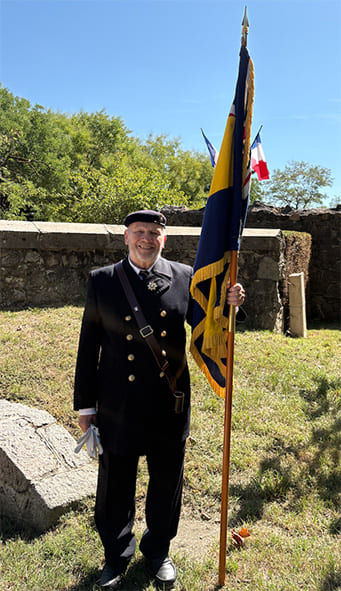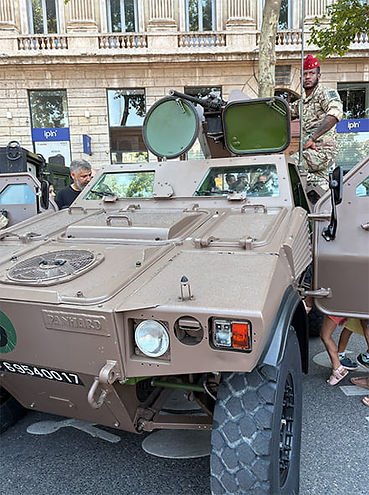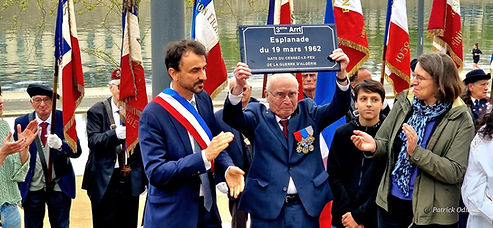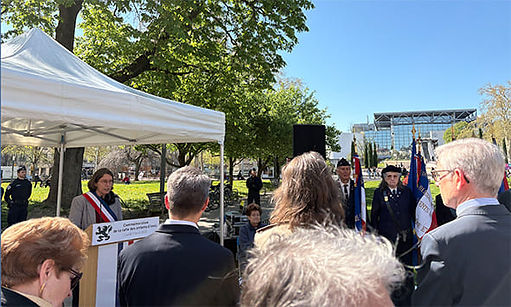ROYAL BRITISH LEGION
Liberation Branch
Président du Royal British Legion, Lyon Liberation Branch : Garth DRURY
lyonliberation.secretary@rbl.communitirbl.org.uk
et garthlyon@gmail.com
Tél. 06 13 64 00 18.

The aim of the British Legion, officially known as the Royal British Legion, is to support members of the British Armed Forces community, including:
-
Serving personnel
-
Veterans
-
Their families and dependents
Main Goals :
-
Welfare and Support: Providing financial, emotional, and practical support to those in need.
-
Remembrance: Promoting remembrance of those who have died or suffered in wars and conflicts, particularly through events like Remembrance Sunday and the Poppy Appeal.
-
Advocacy: Campaigning on behalf of the Armed Forces community to ensure they receive proper support from government and society.
-
Community Building: Running local branches and clubs to offer camaraderie and support networks.
Founded in 1921, the British Legion plays a key role in honoring the sacrifices of the military while helping those affected by service.
The Liberation Branch of the Royal British Legion is a special branch that focuses particularly on veterans and families who were involved in the liberation of Europe during World War II, especially those connected to the Normandy landings (D-Day) and subsequent campaigns.
Main Aims of the Liberation Branch :
-
Commemoration and Remembrance
-
Honoring those who participated in the liberation of Europe, especially in France, Belgium, and the Netherlands.
-
Supporting remembrance events such as D-Day anniversaries and commemorations in Normandy and other liberated areas.
-
-
Supporting Veterans and Families Abroad
-
Assisting veterans who settled in continental Europe after the war.
-
Providing a community for ex-service personnel and their descendants who live in France or other parts of Europe.
-
-
Promoting Education and Awareness
-
Helping local and international communities, especially younger generations, understand the sacrifices made during WWII.
-
Collaborating with schools and memorial organizations to keep the history alive.
-
-
Maintaining International Links
-
Strengthening ties between the UK and countries liberated during WWII.
-
Working with local authorities and associations in countries like France to ensure shared remembrance.
-
The Liberation Branch serves as a living link between the legacy of WWII and the present-day mission of the Royal British Legion, ensuring that the sacrifices of those involved in the liberation of Europe are never forgotten.
L’objectif de la British Legion, officiellement connue sous le nom de Royal British Legion, est de soutenir les membres de la communauté des Forces armées britanniques, notamment
-
Le personnel en service
-
Les anciens combattants
-
Leurs familles et personnes à charge
Objectifs principaux :
-
Bien-être et soutien : fournir une aide financière, émotionnelle et pratique à ceux qui en ont besoin.
-
Mémoire et commémoration : promouvoir la mémoire de ceux qui sont morts ou ont souffert dans les guerres et conflits, notamment à travers des événements comme le Remembrance Sunday et la Poppy Appeal.
-
Plaidoyer : mener des actions pour défendre les intérêts de la communauté militaire afin de garantir qu’elle reçoive un soutien approprié de la part du gouvernement et de la société.
-
Cohésion communautaire : gérer des antennes et clubs locaux pour offrir camaraderie et réseaux de soutien.
Fondée en 1921, la British Legion joue un rôle essentiel dans l’hommage rendu aux sacrifices des militaires tout en aidant ceux qui ont été affectés par leur service.
La Liberation Branch de la Royal British Legion est une branche spéciale qui se concentre particulièrement sur les anciens combattants et les familles ayant participé à la libération de l’Europe pendant la Seconde Guerre mondiale, en particulier ceux liés aux débarquements de Normandie (D-Day) et aux campagnes qui ont suivi.
Objectifs principaux de la Liberation Branch :
-
Commémoration et mémoire :
-
Honorer ceux qui ont participé à la libération de l’Europe, notamment en France, en Belgique et aux Pays-Bas.
-
Soutenir les événements commémoratifs tels que les anniversaires du D-Day et les cérémonies en Normandie et dans d’autres zones libérées.
-
-
Soutien aux anciens combattants et familles à l’étranger
-
Aider les vétérans qui se sont installés en Europe continentale après la guerre.
-
Offrir une communauté aux anciens militaires et à leurs descendants vivant en France ou dans d’autres régions d’Europe.
-
-
Promotion de l’éducation et de la sensibilisation
-
Aider les communautés locales et internationales, en particulier les jeunes générations, à comprendre les sacrifices consentis pendant la 2è Guerre mondiale.
-
Collaborer avec les écoles et les organisations mémorielles pour maintenir vivante l’histoire.
-
-
Maintien des liens internationaux
-
Renforcer les relations entre le Royaume-Uni et les pays libérés pendant la Seconde Guerre mondiale.
-
Travailler avec les autorités locales et les associations dans des pays comme la France pour assurer une mémoire partagée.
-
La Liberation Branch sert de lien vivant entre l’héritage de la Seconde Guerre mondiale et la mission actuelle de la Royal British Legion, en veillant à ce que les sacrifices de ceux qui ont participé à la libération de l’Europe ne soient jamais oubliés.
La vie de notre association
Cliquer ICI pour consulter le calendrier des événements auxquels nous participons
Samedi 22 novembre 2025, notre association tenait son Assemblée générale, à la Maison du Combattant, rue Saint-Polycarpe, à Lyon.

Samedi 15 novembre 2025, à Saint-Germain-au-Mont d'Or : Cérémonie annuelle en hommage aux soldats anglais de la Grande guerre. RdV au cimetière à 10h00.
Participation de la ROYAL BRITISH LEGION, LIBERATION BRANCH.
Lire l'article paru dans Farac Infos en 2017, cliquer ici.
Article in english, click here.
(CMAJ 16/11/2025 , 23/11/2025)

Samedi 6 septembre 2025. Place Général Brosset, Lyon 6è. Hommage aux FFL.












Jeudi 4 septembre, au Mémorial SAS à Sennecey-le-Grand (71)





Mercredi 3 septembre 2025. Libération de Lyon, place Bellecour.


Mardi 2 septembre 2025. Dévoilement par le maire de Lyon, aux côtés des Rescapés de Montluc, d'une plaque en mémoire des victimes assassinées par la Gestapo au 32 place Bellecour - Lyon 2ème



Mardi 30 août 2025, Lyon. Commémoration du massacre de la rue Tronchet.
Pour la douzième fois fut célébré le
souvenir des victimes d’une fusillade
par les forces d’occupation nazies qui
eut lieu au cœur du 6e, seulement
quelques jours avant la Libération de
Lyon, en 1944. La plaque a été financée
par les habitants du quartier.



Dimanche 24 août 2025. Commémoration de la libération de la prison de Montluc, Lyon.







Jeudi 23 août 2025. Commémoration du 81è anniversaire du massacre du fort de Côte Lorette, à Saint-Genis-Laval (69)






Lundi 14 juillet 2025, place Bellecour, à Lyon. Célébration de la Fête Nationale.





Dimanche 13 juillet 2025. Hommage à la Résistance, au cimetière franco-britannique d'Ouroux-en-Morvan (58).



Jeudi 8 mai 2025, commémoration de la Victoire du 8 mai 1945, au Parc de la Tête d'Or, à Lyon.






Dimanche 27 avril 2025, Journée du souvenir des victimes de la déportation. Place Bellecour, Lyon.



Dimanche 13 avril 2025, inauguration à Lyon de l'Espanade du 19 mars 1962, au pont de la Guillotière.



Lundi 7 avril : commémoration de la rafle des enfant d'Izieu. Place Carnot, Lyon.



Lundi 31 mars 2025 : réception en l'honneur des porte-drapeaux à l'Hôtel de ville de Lyon.







Vendredi 21 février 2025 : commémoration de la bataille de Verdun. Place Carnot, Lyon.




Dimanche 9 février. Commémoration de la rafle de la rue Sainte-Catherine, Lyon. Place Carnot, Lyon 2è


Dimanche 26 janvier 2025. Dévoilement du Mémorial de la Shoah. Place Carnot. Lyon 2è.





La cérémonie franco-anglaise annuelle à Saint-Germain-au-Mont-d'Or (Rhône) commémore les liens historiques entre les deux nations, notamment la présence d’un camp militaire britannique dans la commune pendant la Première Guerre mondiale. En 2024, elle s'est tenue le samedi 16 novembre avec des étapes au cimetière anglais, au cimetière français, et à la stèle du Captain King sur l’Esplanade de la Mendillonne. Cet événement a rassemblé les habitants et les représentants officiels pour honorer les soldats tombés lors du conflit.
En savoir plus et photos : cliquer ici. (Publié le 13/12/2024)

16 novembre 2024 : Cérémonie franco-anglaise annuelle à Saint-Germain-au-Mont-d'Or



Dès 1917, le camp des lignes de communication n°2 a été installé par l'armée britannique à Saint-Germain-au-Mont d'Or (Rhône) pour le repos des blessés et des convalescents. Il a surtout été un camp de transit des marins et aviateurs anglais et de l'Empire britannique (Australie, Nouvelle-Zélande, Inde, Népal,...) entre la Méditerranée, les ports de la Manche, les champs de bataille français et ceux du Moyen-Orient. Plus de 700.000 soldats sont passés par ce camp. Entre 700 et 1000 hommes y débarquaient chaque jour. Situé entre la gare et la mairie, le camp comportait 150 tentes circulaires ainsi que des baraquements pour les mess, cuisines, sanitaires, etc.
Le croquis relate avec humour l'état pitoyable à leur arrivée et la santé retrouvée après un séjour dans le camp.



Les blessures graves et les fièvres mortelles ramenées du Moyen-Orient provoquèrent de nombreux décès. Les premières victimes furent inhumées dans le cimetière communal, puis dans une extension de celui-ci, le cimetière britannique, où se déroule aujourd'hui les cérémonies de commémoration, en présence des représentants de l'association Franco-Anglaise, de la Royal British Legion Lyon Branch, de la Royal Air Forces Association et de nombreux habitants du village accompagnés de leurs enfants.

Après les hommages prononcés par la Maire de Saint-Germain au Mont d'Or et deux prêtres, la cérémonie s'est poursuivie au cimetière du village.


Un hommage a été rendu aux orphelins et veuves de guerre ainsi qu'au capitain Garton-King (1890-†1968) , ancien officier au Royal West Kent Regiment pendant la Grande guerre et consul puis consul général à Lyon de 1921 à 1923.


Les enfants des écoles ont lu des textes, préparés avec leurs maîtres, sur la correspondace que des Polius auraient pu écrire durant cette longue et terrible guerre.

Garth Drury, président
et porte-drapeau de la Royal British Legion Lyon Branch.

